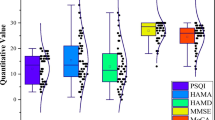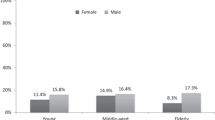Abstract
The epidemiological study presented here was conducted to examine the association between sleep problems and restless legs syndrome (RLS) among a large sample taken from the general population of Japan. The presence of RLS was established by asking the subjects if they experienced a crawling sensation in their legs after going to bed. This survey was performed in June 2000, targeting a sample that was randomly selected from 300 communities throughout Japan. The questionnaire contained questions focusing on health consciousness, mental health, and sleep. A total of 26 705 participants completed the questionnaire. The prevalence of RLS was 3.0%, with a significant predominance in women. The prevalence of RLS increased significantly with advancing age. Multiple logistic regression analysis revealed that RLS was significantly associated with difficulty initiating sleep (odds ratio, OR = 2.58), excessive daytime sleepiness (OR = 2.28), difficulty maintaining sleep (OR = 1.71), non-restorative sleep (OR = 1.51), subjective insufficient sleep (OR = 1.36), and early morning awakening (OR = 1.21). These results suggest that the prevalence of RLS in Japan is lower than in northern European populations and that RLS is strongly associated with difficulty initiating sleep and excessive daytime sleepiness.
Similar content being viewed by others
References
American Academy of Sleep Medicine. International Classification of Sleep Disorders, 2nd edn, Diagnostic and Coding Manual. Westchester, IL: American Academy of Sleep Medicine, 2005.
Berger K, Luedemann J, Trenkwalder C et al. Sex and the risk of restless legs syndrome in the general population. Arch. Intern. Med. 2004; 164: 196–202.
Bjorvatn B, Leissner L, Ulfberg J et al. Prevalence, severity and risk factors of restless legs syndrome in the general adult population in two Scandinavian countries. Sleep Med. 2005; 6: 307–12.
Tison F, Crochard A, Leger D et al. Epidemiology of restless legs syndrome in French adults: a nationwide survey: the INSTANT Study. Neurology 2005; 65: 239–46.
Ohayon MM, Roth T. Prevalence of restless legs syndrome and periodic limb movement disorder in the general population. J. Psychosom. Res. 2002; 53: 547–54.
Kim K, Uchiyama M, Okawa M, Liu X, Ogihara R. An epidemiological study of insomnia among the Japanese general population. Sleep 2000; 23: 41–7.
Doi Y, Minowa M, Okawa M, Uchiyama M. Prevalence of sleep disturbance and hypnotic medication use in relation to sociodemographic factors in the general Japanese adult population. J. Epidemiol. 2000; 10: 79–86.
Liu X, Uchiyama M, Kim K et al. Sleep loss and daytime sleepiness in the general adult population of Japan: the national epidemiological survey. Psychiatry Res. 2000; 93: 1–11.
Kaneita Y, Ohida T, Uchiyama M et al. Excessive daytime sleepiness among the Japanese population. J. Epidemiol. 2005; 15: 1–8.
The Ministry of Health.Labour and Welfare Active Survey of Health and Welfare 1997. [Cited 13 January 2006.] Available from URL: http://www1.mhlw.go.jp/toukei/h-fukusi/gaiyo.html (In Japanese)
The Ministry of Health.Labour and Welfare, Active Survey of Health and Welfare 1997. [Cited 13 January 2006.] Available from URL: http://www1.mhlw.go.jp/houdou/0906/h0601-1a.html#c (In Japanese.)
Ekbom KA. Restless legs: a clinical study. Acta Med. Scand. Suppl. 1945; 158: 1–122.
Phillips B, Young T, Finn L et al. Epidemiology of restless legs symptoms in adults. Arch. Intern. Med. 2000; 160: 2137–41.
Kim J, Choi C, Shin K et al. Prevalence of restless legs syndrome and associated factors in the Korean adult population: the Korean Health and Genome Study. Psychiatry Clin. Neurosci. 2005; 59: 350–3.
Sevim S, Dogu O, Camdeviren H et al. Unexpectedly low prevalence and unusual characteristics of RLS in Mersin, Turkey. Neurology 2003; 61: 1562–9.
Tan EK, Seah A, See SJ et al. Restless legs syndrome in an Asian population: a study in Singapore. Mov. Disord. 2001; 16: 577–9.
Lavigne GJ, Montplaisir JY. Restless legs syndrome and sleep bruxism: prevalence and association among Canadians. Sleep 1994; 17: 739–43.
Walters AS. Toward a better definition of the restless legs syndrome: the International Restless Legs Syndrome Study Group. Mov. Disord. 1995; 10: 634–42.
Edinger JD, Means MK. Overview of insomnia. Definitions, epidemiology, differential diagnosis, and assessment. In: Kryger MH, Roth T, Dement WC, eds. Principles and Practice of Sleep Medicine, 4th edn. Philadelphia, PA: Elsevier Saunders, 2005; 702–13.
Montplaisir J, Boucher S, Poirier G et al. Clinical, polysomnographic, and genetic characteristics of restless legs syndrome: a study of 133 patients diagnosed with new standard criteria. Mov. Disord. 1997; 12: 61–5.
Hening WA, Walters AS, Wagner M et al. Circadian rhythm of motor restlessness and sensory symptoms in idiopathic restless legs syndrome. Sleep 1999; 22: 901–12.
Michaud M, Dumont M, Selmaoui B et al. Circadian rhythm of restless legs syndrome: relationship with biological markers. Ann. Neurol. 2004; 55: 372–80.
Montplaisir J, Boucher S, Nicolas A et al. Immobilization tests and periodic leg movements in sleep for the diagnosis of restless leg syndrome. Mov. Disord. 1998; 13: 324–9.
Author information
Authors and Affiliations
Corresponding author
Rights and permissions
About this article
Cite this article
Enomoto, M., Li, L., Aritake, S. et al. Restless legs syndrome and its correlation with other sleep problems in the general adult population of Japan. Sleep Biol. Rhythms 4, 153–159 (2006). https://doi.org/10.1111/j.1479-8425.2006.00220.x
Accepted:
Published:
Issue Date:
DOI: https://doi.org/10.1111/j.1479-8425.2006.00220.x




